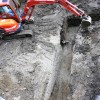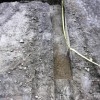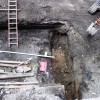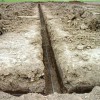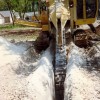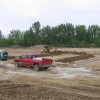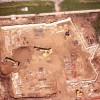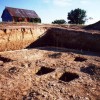Excavation
Video
alt="" Excavation and Trenching ISafety SolutionsExcavation refers to the removal of soils below the grade elevation (ground level) at a project site. An excavation is usually a temporary requirement for the placement of foundation structures, utilities, and basements below grade. Considerations for excavation include the characteristics of the soil at the work location, the required depth and amount of soils to be removed, and any site constraints including adjacent structures and property lines. Depending on the height of the water table and the permeability of the soil being excavated, dewatering may be required if a dry work environment is necessary.
Shallow open excavations are made without any side support, and are appropriate for installing many buried utility services and the construction of uncomplicated foundation systems such as slabs and wall footings. The side slope angle of unsupported open excavations will be determined primarily by soil characteristics. Loose sandy soils will only allow for shallow (flat) side slopes, whereas cohesive clays allow for nearly vertical side slopes in shallow excavations. Where space is ample and side bracing is not available or desired, a series of adjacent shallow excavations are sometimes used to achieve the required work depth below grade. Notably, construction safety regulations may limit the dimensions of shallow open excavations before bracing is required, regardless of the soil characteristics at the project site.
Deep excavations require side support bracing. A common form of bracing used today is a trench-box, typically required for work depths of 5-10 feet. A trench box is composed essentially of two steel side plates connected with telescoping lateral bracing that can be adjusted for varied excavation widths. It is commonly used for utility placement and can be readily repositioned with construction equipment such as a backhoe. Deeper excavations will require a fixed system of vertical sheeting and lateral bracing. Different types of vertical sheeting are commonly used to support the side walls of a deep excavation. Wood sheeting (interlocked vertical wood planks lining the side walls) is routinely utilized for excavation depths of approximately 10-15’. The wood sheeting is then braced laterally from side wall to side wall with struts and wales, which are straight support members similar to beams. If the excavation is even deeper, steel sheet piles, or thin steel side walls, are usually installed and similarly braced. Another alternative is a system of vertical steel H-beam posts with lagging (horizontal wood planks) locked between the H-beam flanges to form the excavation’s side walls.
Backfilling refers to the replacement of soils in an excavation following work completion, to fill any void spaces remaining. Compaction of the backfilled soils is typical, so that soils can be returned to a condition similar to that prior to excavation.

Buildipedia Staff
The Buildipedia research and writing staff consists of dozens of experienced professionals from many sectors of the industry, including architects, designers, contractors, and engineers.
Website: buildipedia.com/

